
There are a variety of conditions and injuries that can cause wrist pain. De Quervain’s tenosynovitis is a condition associated with pain, tenderness, and problems moving the thumb and wrist. If left untreated, the condition can get progressively worse, preventing you from carrying many simple activities.
Although the exact cause of de Quervain’s tenosynovitis is unclear, it is thought to be caused by overusing the wrist and thumb, and repetitive hand movements such as clenching, pinching, gripping, grasping, or wringing objects in your hand. The condition affects the tendons (the tissues that attach muscles to bones) on the thumb side of the wrist. The tendons pass through a tunnel, called a tendon sheath, which allows them to glide smoothly during movement. Repetitive thumb and wrist motions can cause the tendon sheath to become inflamed and thicken, which can irritate the tendons and restrict movement through the sheath.
Symptoms Of De Quervain’s Tenosynovitis
The most common symptoms of de Quervain’s tenosynovitis include:
- Pain and tenderness at the thumb side of the wrist (typically the base of the thumb).
- Swelling at the wrist and in the thumb area.
- Difficulty moving the wrist and thumb, particularly when turning the wrist or carrying out a pinching or grasping motion.
- An audible crackling noise or feeling a catching or sticking sensation when moving the thumb.
- Numbness in the thumb and index finger (if nearby nerves become irritated).
If de Quervain’s tenosynovitis is left untreated, pain may spread into the forearm or further up the thumb. It can also limit the range of motion in the wrist and make using the hand and wrist increasingly difficult. Some individuals may also develop a fluid-filled cyst at the region near the base of the thumb.
Who Is At Risk Of De Quervain’s Tenosynovitis?
De Quervain’s tenosynovitis is more common in women and in those who have hobbies or jobs involving repetitive hand movements, such as gardening or racket sports. Caring for a new baby can also be associated with the condition. This is due to the repeated awkward hand movements required for lifting and caring for a baby, which can put stress on the tendons.
Other risk factors for developing de Quervain’s tenosynovitis can include pregnancy and being between the ages of 30 and 50. De Quervain’s tenosynovitis experienced during pregnancy is usually only temporary and symptoms often improve towards the end of pregnancy or when breastfeeding begins.
When You Should Visit A Doctor
You should visit a doctor if you are experiencing ongoing or significant wrist pain or reduced function in your wrist and thumb, as delaying treatment can make the condition worse.
In order to diagnose de Quervain’s tenosynovitis, your doctor will assess your symptoms and medical history, and carry out an examination of the wrist and hand. A Finkelstein test is typically carried out to confirm a suspected case of de Quervain’s tenosynovitis. The test involves making a fist (with your thumb tucked inside) and then bending your wrist towards the little finger. De Quervain’s tenosynovitis is confirmed if the pain is experienced at the base of the thumb.
Treatment for De Quervain’s Tenosynovitis
Treatment is most successful when started early. Mild symptoms of de Quervain’s tenosynovitis may improve with rest, applying ice to the area, and over-the-counter pain and inflammatory medication. If symptoms don’t start to improve, your doctor may recommend:
- Wearing a splint to support and rest the tendons
- A cortisone injection into the tendon sheath to help reduce swelling
- Physical or occupational therapy to alleviate symptoms and improve strength and movement
When Is Surgery Necessary?
Surgery may be recommended in serious cases, or if symptoms do not improve with conservative treatments. Surgery is typically an outpatient procedure and involves the surgeon making an incision in the tendon sheath. This helps to create more space and relieve pressure on the tendons. Sometimes, swollen tissue in the sheath may also be removed. Following surgery, most patients experience very good results and make a full recovery.
Wrist Pain Relief in North Dakota
If you are experiencing wrist pain or reduced movement, speak to the board-certified and fellowship-trained orthopedic surgeons at The Bone & Joint Center. We have advanced training in common and complex conditions affecting the wrist and can provide a variety of state-of-the-art surgical and nonsurgical treatments to effectively relieve your pain.
If you would like to find out more about our orthopedic services, please call us at (701) 946-7400 / (866) 900-8650.

